Frequently asked questions and answers for Safety Door Switches - Industrial Automation
When the Safety Door Switches are installed, is the direction of installation fixed?
Since the direction of installation for the Safety Door Switches is not fixed, you can install them in any direction.
Therefore, if they are installed upside down or to a position horizontal with the floor surface, no malfunction occurs.
What are the adjustable head directions and possible points to insert the operation key for D4DS Safety-door Switches?
As shown in the following figure, the Head can be adjusted into four directions (directions 1 to 4 in the figure) and the key can be inserted at eight points (points 1 to 8 in the figure).
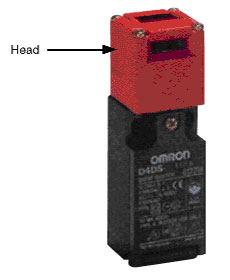
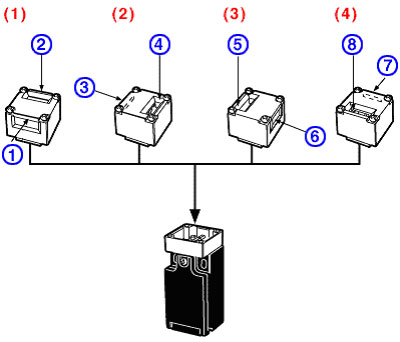
What is a mechanical lock?
A mechanical lock is used in some electromagnetically lock safety door switches, whereby the switch locks automatically when the operating key is inserted.
The lock is released when electricity flows to the solenoid.
A release key can be used to release the lock during power stoppages.
Applicable models:
D4BL-[][][]A Guard Lock Safety-door Switch
D4BL-[][][]B Guard Lock Safety-door Switch
Do the indicator terminals for D4DL Safety-door Switches and D4BL have polarity?
No, they do not.
What is diversity?
Common malfunctions and the probability of failure in electric products can be reduced if each product uses a variety of control circuits as well as various types of devices and components. The following are examples showing the use of diversity.
Safety door with safety components that use a combination of NC and NO contacts.
Circuits using control components that are different from each other in type.
Redundant combinations of electromechanical and electronic circuits.
The following diagram shows an example of operating a safety door using a combination of negative operation and positive operation switches.

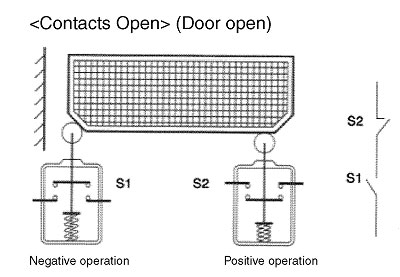
What is negative operation and positive operation?

Do the Safety Door Switches and Safety Limit Switches have the polarity when used with direct current?
No, they do not have any polarity.
What is slow action?
SPST-NC + SPST-NO contact slow action has a direct opening mechanism (forcibly opened contacts) defined under EN 60497-5-1. The NC contact side is the only side with a direct opening mechanism (forcibly opened contacts). When contact welding occur, a plunger is pushed down to open the NC contacts and break the circuit.
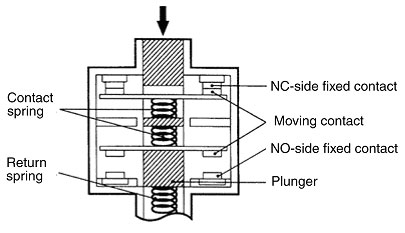
DPST-NC contact slow action has a direct opening mechanism (forcibly opened contacts) defined under EN60497-5-1. Both NC contact sides have a direct opening mechanism (forcibly opened contacts).
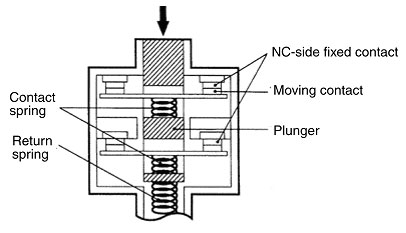
What is D4NH Safety-door Hinge Switch?

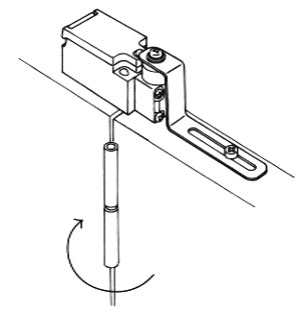
What is a direct opening mechanism (forcibly opened contacts) ?
A direct opening mechanism is one that forces open a welded contact by the direct force applied by the actuator (operating section) pressing down.
Safety components with direct opening mechanism (forcibly opened contacts) display the mark(*) on their labels.

Direct Opening Mechanism (Forcibly Opened Contacts)

After the contacts have been forced open, the contacts have enough insulation between them to clear the stipulated impulse withstand voltage (EN 60947-5-1) when the specified operating force (corresponding to DOF) or stroke (corresponding to DOT) is applied against a force of 10 N applied to the contacts (equivalent to the contact weld force).
What are the applications for D4BL Guard Lock Safety-door Switch release keys?
The release keys are used to release locks during power interruptions and in emergencies.
The lock is released and the safety door or other device is opened by using the supplied special release key to move from the LOCK position to the UNLOCK position.

Note:The locks are shipped set to the UNLOCK position and must always be set to the LOCK position before use.
What is redundancy?
Redundancy is duplication. The probability of hazards arising from one malfunction in an electrical circuit can be minimized by creating partial or complete Redundancy (duplication).
The following diagram shows an example circuit where the use of two or more relays or switches in parallel enables performing the total function if one of them is malfunctioning.
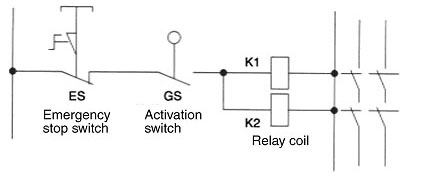

What are the symbols for NC and NO contacts?
NC Contacts: Contacts that are normally closed.
Symbol

NO Contacts: Contacts that are normally open.

Do any Safety Door Switches comply with category 4?
Switches with direct opening mechanisms (forcibly opened contacts) can be used in category 4 circuits, but the category applies to the whole system and is not achieved by a Safety Door Switch alone.
What is the conduit section?
The duct openings and wiring openings in Safety Door Switches and Safety Limit Switches are called the conduit sections and this is where the wiring section is sealed.
Refer to the following photographs of structural cross-sections of a D4BS-series Switch.
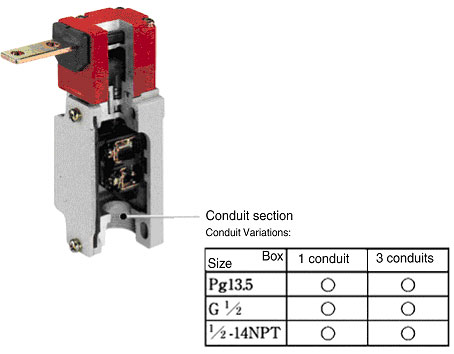
One-conduit models have one conduit section on the switch.
Two-conduit models have two conduit sections on the switch
Three-conduit models have three conduit sections on the switch.
Example: D4DS-15FS
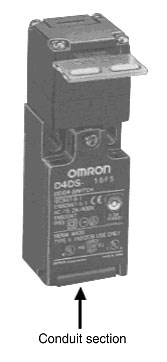
Example: D4DS-55FS
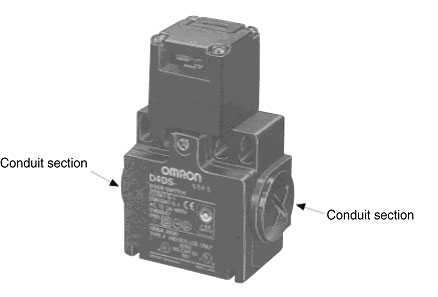
Example: D4BS-55FS
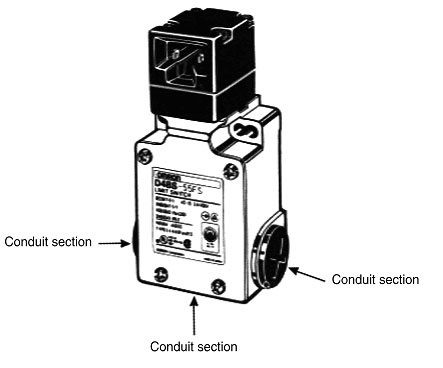
What are Safety Door Switches with adjustable head directions?
I'm using D4DL/D4BL Safety-door Switches with a mechanical lock. If the solenoid power is turned ON to release the lock, the door is opened, and then the power to the solenoid is turned OFF, will D4DL/D4BL lock by itself when the key is inserted?
Yes, it will lock if you simply insert the key.
Where can D4BL-series Guard Lock Safety-door Switch be used?
Use these switches in machinery or equipment with rotating sections, where the machine is not immediately safe once the power is turned OFF.
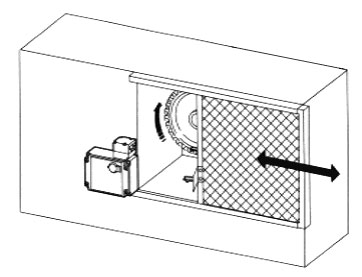
The key comes out of D4DL/D4BL Safety-door Switches with a mechanical lock if I insert the key and then turn OFF the solenoid. What causes this and how can I correct it?
Cause: The release key is in the unlock position. The lock will not engage in the unlock position.
Countermeasure: Set the release key to the lock position.
What is Y/Za/Zb?
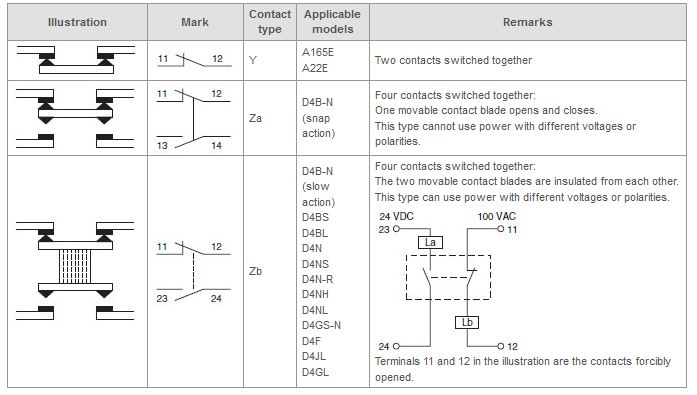
What is a Guard Lock Safety-door Switch?
It is a door switch that can lock doors. There is a mechanical lock method and a solenoid lock method.
Applicable models:
D4BL Series
D4JL Series
D4NL Series